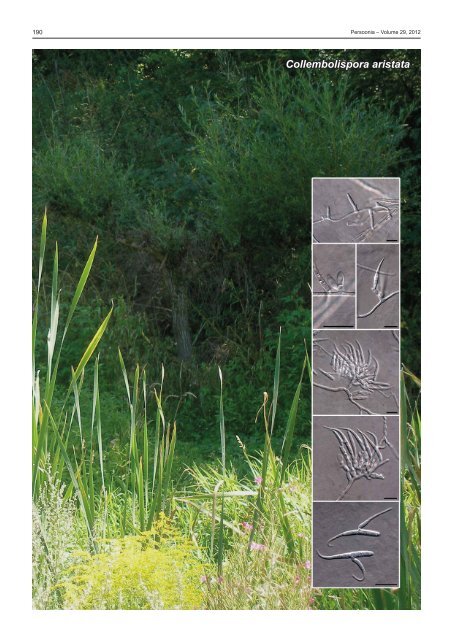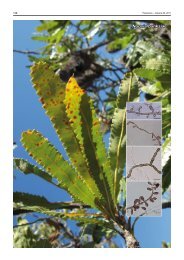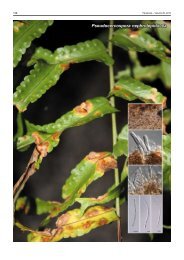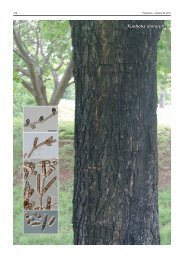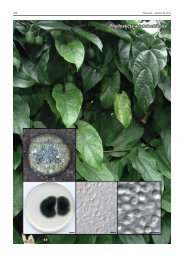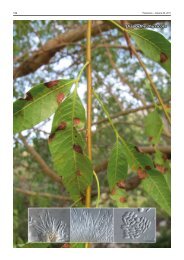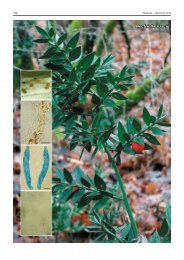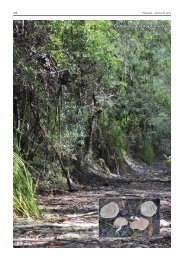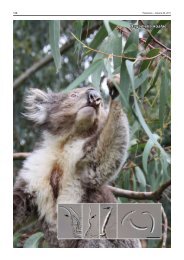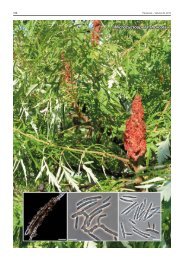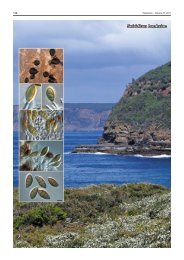Collembolispora aristata - Fungal Planet
Collembolispora aristata - Fungal Planet
Collembolispora aristata - Fungal Planet
Create successful ePaper yourself
Turn your PDF publications into a flip-book with our unique Google optimized e-Paper software.
190 Persoonia – Volume 29, 2012<br />
<strong>Collembolispora</strong> <strong>aristata</strong>
<strong>Fungal</strong> <strong>Planet</strong> description sheets<br />
191<br />
<strong>Fungal</strong> <strong>Planet</strong> 149 – 20 December 2012<br />
<strong>Collembolispora</strong> <strong>aristata</strong> Marvanová & J.Z. Groenew., sp. nov.<br />
Etymology. aristatus (L.) = with bristles.<br />
Conidia isolated from foam according to the methodology of<br />
Marvanová et al. (2003). Colonies on malt agar medium fast<br />
growing, reaching 25 mm after 20 d at 12 °C, dark grey, reverse<br />
black. Aerial mycelium abundant, lanose to funiculose.<br />
Hyphae glabrous, hyaline, thin-walled, 1–3 µm wide or dark<br />
brown, thicker-walled, up to 5 µm wide. Sporulation initially<br />
directly on agar, in subcultures after submergence in standing<br />
distilled water at 15 °C within a few days. Conidiophores intercalary,<br />
lateral or terminal, simple to profusely branched; stipes,<br />
if present, cylindrical or distally slightly widening up to 32 ×<br />
1.5–3.5 µm, with branches on various levels along the stipes<br />
or in a penicillate head; often concurrent with conidiogenous<br />
cells, sometimes verticillate, cylindrical or subclavate, 4–8 ×<br />
2–3 µm. Conidiogenous cells subclavate to narrow-doliiform,<br />
usually 1–3 per conidiophore branch, polyblastic sympodial,<br />
5–11 × 1.5–3 µm, with one to few denticles at the apex, scars<br />
flat. Conidia in slimy masses when formed outside water, appearing<br />
in close sequence. Axis 31–46 × 2–3.5 µm, proximal<br />
part obclavate and unequilateral, mildly curved or straight,<br />
3(–5)-septate, basal scar truncate, sometimes eccentric,<br />
apex with an integrated, setose extension sometimes slightly<br />
curved away; branch single (exceptionally two), typically ventral,<br />
rarely dorsal, usually arising from the second suprabasal<br />
cell of the axis, often strongly retrorse, but also perpendicular<br />
to the axis, straight or often slightly curved abaxially, rarely<br />
adaxially, proximal part obclavate, base often slightly sinuous,<br />
16–30 × 1.5–2.7 µm, insertion unequally constricted, distally<br />
protracted into setose extension. Some considerably swollen<br />
conidia are usually present in submerged cultures after several<br />
weeks. Hyphopodia-like outgrowths may appear in aged,<br />
submerged cultures on hyphae, and also on conidia.<br />
Typus. Czech Republic, South Moravian region, between the villages<br />
Ochoz uTišnova and Lomnice, c. 440 m alt., isolated from foam in an unnamed<br />
left tributary of the Křeptovský potok stream (the streamlet is shallow,<br />
80–100 cm wide, slow-flowing, with grasses on the banks and Typha<br />
latifolia and Glyceria maxima in the littoral zone), Mar. 1984, L. Marvanová,<br />
holotype CBS H-21090, culture ex-type CPC 21145 = CCM F-01585 = CBS<br />
115662; ITS sequence GenBank KC005789, LSU sequence GenBank<br />
KC005811, MycoBank MB491201.<br />
Notes — The hyphomycete genus <strong>Collembolispora</strong> is<br />
based on C. barbata, isolated from Alnus glutinosa leaf baits<br />
submerged in a slow-flowing, oligotrophic softwater stream in<br />
North Portugal (Marvanová et al. 2003). <strong>Collembolispora</strong> <strong>aristata</strong><br />
has similar colonies, conidiogenesis as well as conidia<br />
like C. barbata, but the conidia of the latter differ from those of<br />
C. <strong>aristata</strong> by having a branched, terminal, setose extension<br />
on the conidial axis and on the conidial branch, and by the<br />
presence of a hyphomycetous, phialidic (?spermatial) morph.<br />
As far as we know, there is thus far only one other report on<br />
conidia of C. <strong>aristata</strong> (Roldán & Puig 1992, f. 3C, as Gyoerffyella<br />
sp.). These authors collected detached conidia in<br />
a stream in the river Esva basin in the Asturias Province of<br />
Northern Spain, 285 m alt., in a site where the riparian vegetation<br />
consists predominantly of grasses.<br />
Conidia of C. <strong>aristata</strong> resemble those of Ramulispora bromi,<br />
which is a grass parasite causing spots on Bromus spp. In fact<br />
the conidia illustrated by Sprague (1950, f. 76), resemble underdeveloped<br />
conidia of C. <strong>aristata</strong>, without long extensions.<br />
According to Braun (1995), R. bromi is an insufficiently known<br />
species, with conidia resembling those of Mycocentrospora<br />
or Spermospora. Ramulispora is based on R. andropogonis,<br />
which according to Braun (1995) is a facultative (taxonomic)<br />
synonym of R. sorghi, based on Septorella sorghi. Conidia of<br />
R. sorghi are filiform to narrow obclavate, sometimes with 1–2<br />
lateral branches. Ramulispora sorghi is anamorphic Mycosphaerellaceae,<br />
Dothideomycetes (Crous et al. 2009a, c).<br />
<strong>Collembolispora</strong> <strong>aristata</strong> conidia are superficially also similar<br />
to those of two Gyoerffyella species with single-branched<br />
non-coiled conidia (G. entomobryoides and G. tricapillata).<br />
However, members of this holoanamorphic genus have pale<br />
colonies and polyblastic, clavate conidiogenous cells, which<br />
do not proliferate.<br />
Phylogenetically <strong>Collembolispora</strong> clusters in the Helotiales,<br />
with the nearest group formed by strains of Leptodontidium<br />
orchidicola. Leptodontidium was established for dematiaceous<br />
endophytes in roots of various plants growing in cool<br />
soils rich in humus (Fernando & Currah 1995). Based on a<br />
megablast search of NCBIs GenBank nucleotide database,<br />
the closest hits using the LSU sequence are Cadophora luteoolivacea<br />
(GenBank HM116760; Identities = 907/913 (99 %),<br />
Gaps = 0/913 (0 %)) and Mollisia dextrinospora (GenBank<br />
HM116757; Identities = 906/913 (99 %), Gaps = 0/913 (0 %)).<br />
Closest hits using the ITS sequence had highest similarity to<br />
<strong>Collembolispora</strong> barbata (GenBank GQ411302; Identities =<br />
559/576 (97 %), Gaps = 7/576 (1 %)) and Leptodontidium orchidicola<br />
(GenBank GU586841; Identities = 555/580 (96 %),<br />
Gaps = 10/580 (2 %)).<br />
There is little information on the ecology of species of <strong>Collembolispora</strong>.<br />
It is not known whether they should be considered<br />
indwellers, residents or transients (in the sense of Park 1972)<br />
in the water environment. In both localities of C. <strong>aristata</strong>, Poaceae<br />
were present on the stream banks or in the littoral zone.<br />
Although the occurrence of Poaceae at the type locality may<br />
support the hypothesis about relationships between R. bromi<br />
and C. <strong>aristata</strong>, the phylogenetic affinity suggests this not to<br />
be the case.<br />
Colour illustrations. Left tributary of the stream Křeptovský potok between<br />
the villages Ochoz u Tišnova and Lomnice; conidiophores, conidiogenous<br />
cells and appendaged conidia. Scale bars = 10 µm.<br />
Ludmilla Marvanová, Czech Collection of Microorganisms, Institute of Experimental Biology, Faculty of Science, Masaryk University,<br />
Tvrdého 14, 602 00 Brno, Czech Republic; e-mail: ludmila@sci.muni.cz<br />
Johannes Z. Groenewald, CBS-KNAW <strong>Fungal</strong> Biodiversity Centre, P.O. Box 85167, 3508 AD Utrecht, The Netherlands;<br />
e-mail: e.groenewald@cbs.knaw.nl<br />
© 2012 Nationaal Herbarium Nederland & Centraalbureau voor Schimmelcultures


